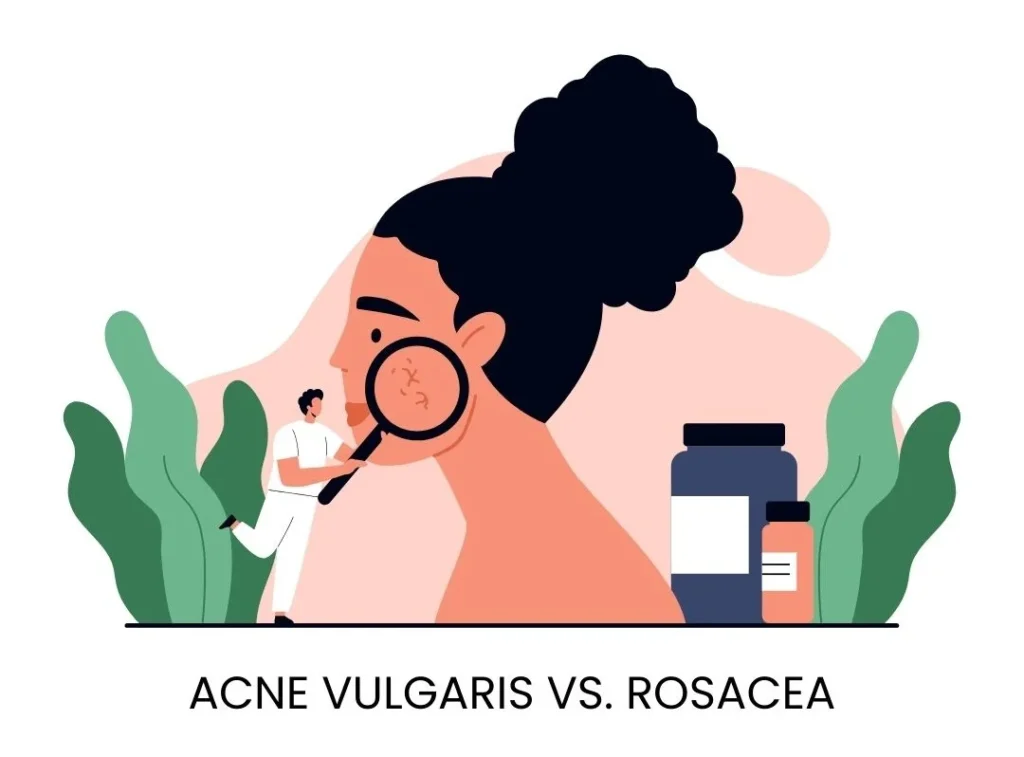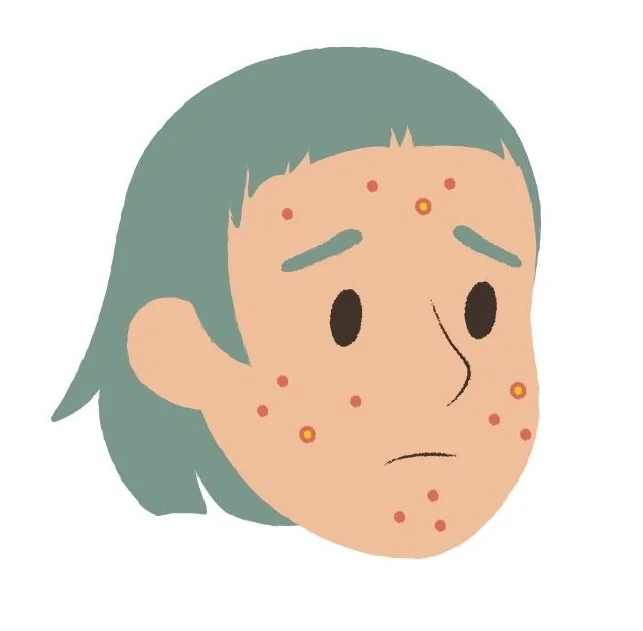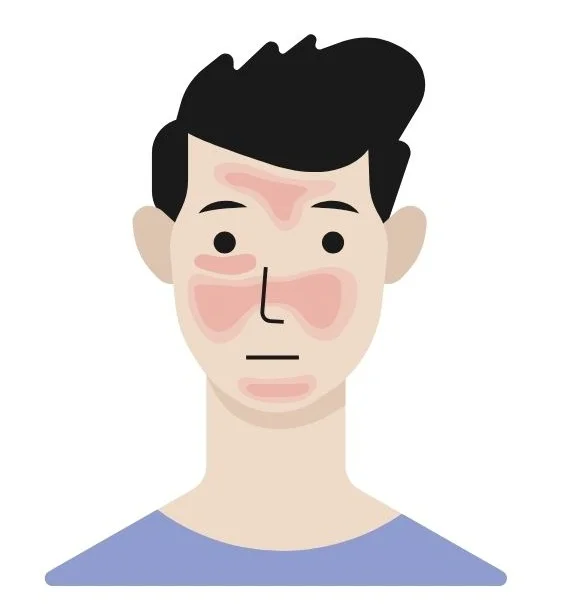
If you are searching for a natural treatment for acne and rosacea or wondering which of these skin conditions you are dealing with, you are not alone.
Many people confuse acne vulgaris and rosacea, especially when they see red, inflamed bumps on their skin.
However, these conditions are different in their causes, symptoms, and treatment approaches.
In this detailed guide, we will break down acne vulgaris vs. rosacea, help you understand the signs of each, and explore the best homeopathic remedies to manage and heal your skin naturally.
Whether you are looking for homeopathy for rosacea or the best homeopathic treatment for acne, this article will serve as your go-to reference.
Table of Contents
ToggleWhat is Acne Vulgaris?

Acne vulgaris is one of the most common skin conditions, especially among teenagers and young adults.
It occurs when pores get clogged due to excess oil (sebum), dead skin cells, and bacteria, leading to inflammation.
Hormonal changes play a major role, which is why acne often begins at puberty.
Symptoms of Acne Vulgaris
- Blackheads: These are open clogged pores that appear black due to oxidation.
- Whiteheads: Closed clogged pores that look white or flesh-coloured.
- Papules and Pustules: Small red or pink bumps, often with pus.
- Nodules and Cysts: Large, painful lumps deep under the skin; more likely to cause scarring.
Common Areas Affected by Acne
- Face (especially the T-zone)
- Back
- Chest
- Shoulders
Triggers for Acne Vulgaris
- Hormonal changes during puberty, menstruation, or pregnancy
- High-glycaemic diets, processed sugar, and dairy products
- Oily or comedogenic skincare and makeup products
- Stress, which increases cortisol and oil production
READ A DETAILED POST ON HOMOEOPATHIC TREATMENT FOR ACNE
What is Rosacea?

Rosacea is a chronic inflammatory skin disorder primarily affecting adults between the ages of 30 and 50.
Unlike acne, it is not caused by blocked pores or bacterial infection.
Instead, rosacea involves vascular dysfunction and a hypersensitive response to environmental triggers.
Symptoms of Rosacea
- Frequent flushing and facial redness
- Persistent redness around the cheeks, nose, forehead, and chin
- Acne-like papules and pustules (but no blackheads or whiteheads)
- Visible tiny blood vessels on the surface of the skin (telangiectasia)
- Thickened skin on the nose in advanced cases (rhinophyma)
Common Areas Affected by Rosacea
- Cheeks
- Nose
- Forehead
- Chin
Common Triggers for Rosacea
- Sun exposure
- Spicy food
- Alcohol, especially red wine
- Hot beverages
- Stress or emotional upheaval
- Extreme temperatures or heat
HERE IS A DETAILED POST ON TREATMENT FOR ROSACEA BY HOMEOPATHY
Homeopathic Treatment for Acne and Rosacea
Homeopathy provides a holistic and individualized approach to healing the skin by stimulating the body’s natural defences.
Remedies are selected based on the person’s constitution, emotional state, and skin symptoms.
Homeopathic Remedies for Acne Vulgaris
- Hepar Sulphur: Best for painful, pus-filled acne that worsens with cold and touch. Skin is highly sensitive.
- Sulphur: Ideal for red, itchy, inflamed acne that worsens with heat. Often used when the skin is oily and unclean.
- Silicea: Suitable for deep, cystic acne that forms slowly and contains pus. Helps with healing and scarring.
- Calcarea Sulphurica: Works well for persistent acne with yellow, thick discharge. Especially effective for teenage acne.
- Natrum Muriaticum: Best for oily skin with acne triggered by hormonal imbalances or emotional stress.
- Pulsatilla: Helps women with acne due to hormonal changes, especially before menstruation.
Homeopathic Remedies for Rosacea
- Belladonna: Useful when there is sudden redness, heat, and burning sensations. Skin looks hot and flushed.
- Lachesis: Ideal for rosacea worsened by alcohol, spicy foods, and heat. Often used in cases linked to menopause or hormonal issues.
- Sanguinaria Canadensis: Excellent for rosacea with intense redness, especially over the cheeks and nose.
- Arsenicum Album: Used for dry, burning, and sensitive skin. The patient may be anxious and restless.
- Apis Mellifica: Helps in cases with facial swelling, stinging, and warm skin sensations.
- Carbo Vegetabilis: Beneficial when there are visible blood vessels, weak circulation, and a feeling of skin congestion.
Tips for Healing Acne and Rosacea Naturally
- Stick to your homeopathic prescription – Consistency is key for visible results.
- Avoid known dietary and environmental triggers.
- Maintain gentle skincare routines – Avoid harsh scrubs, exfoliants, or strong cleansers.
- Keep the skin hydrated with soothing, non-comedogenic moisturizers.
- Manage stress through relaxation techniques like meditation or nature walks.
Final Thoughts
Understanding whether you have acne vulgaris or rosacea is the first step toward effective and lasting treatment. While both can look similar on the surface, their roots are quite different.
The good news is that homeopathy offers a personalized, non-toxic, and natural solution for both conditions.
If you’re looking for a gentle, long-term remedy, consult a certified homeopath who can guide you based on your individual symptoms and health history.
Have you tried homeopathic treatment for acne or rosacea? Share your experience and questions in the comments below—we’d love to hear your story!
